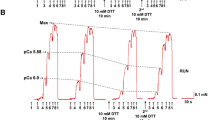Summary
Two age groups of Wistar male rats (90 and 150 days) subdivided according to motor activity regime (restriction of activity in chambers 8×12×20 cm since weaning; controls; 3 hrs lasting daily exercise of medium intensity on a motor-driven treadmill) were followed. Percent body fat and body weight were lowest in the exercised animals in spite of relatively highest caloric intake, which was, on the other hand, lowest in the hypokinetic animals which had the same weight and body fat as controls. Free fatty acid level and inflow-outflow rate of injected palmitate-14C ascertained at rest was significantly lowest in hypokinetic animals. The inflow of palmitate-14C was always higher to the adipose tissue and lower to the soleus, resp. heart muscles in hypokinetic rats; the reverse applied to the exercised rats in which a higher proportion of palmitate-14C was distributed to the soleus and heart muscles even at rest. The inflow of palmitate-14C to the soleus and heart muscles of the hypokinetic animals was significantly lower than to soleus and heart muscles of the exercised animals; the reverse results were found in the adipose tissue. Adaptive changes in lipid metabolism due to long-term hypokinesia and/or exercise were obviously permanent and manifested therefore even without work-load, causing inter alia final characteristic changes in fat deposition in spite of correspondingly modified regulation of food intake.
Similar content being viewed by others
References
Baker, N., Rostam, H.: Effect of glucose feeding on net transport of plasma free fatty acids. J. Lipid Res. 10, 83–90 (1969)
Crawford, M. A.: Fatty acid rations in free living and domesticated animals. Possible implications for atheroma. Lancet I 1968, 1329
George, J. S., Vallyathan, N. V.: Effect of the disuse atrophy on pectoralis muscle and blood in the pigeon. Amer. J. Physiol. 202, 268–275 (1962)
Havel, R. J.: Influence of intensity and duration of exercise on supply and use of fuels. In: Muscle metabolism during exercise, B. Pernow, B. Saltin, eds., pp. 315–325. New York-London: Plenum Press 1971
Issekutz, B., Jr., Miller, H., Paul, P., Rodahl, K.: Aerobic work capacity and plasma free fatty acid turnover. J. appl. Physiol. 20, 239–244 (1965)
Pařízková, J.: Physical activity and body composition. Symposium Soc. Study Hum. Biol., London, August 1963. In: Human body composition, J. Brožek, ed., pp. 161–176. Oxford: Pergamon Press 1965
Pařízková, J.: The effect of age and various motor activity on fat content, lipoproteinase activity and experimental necrosis in the rat heart. 1st Symposium “Biochemistry of exercise”, Brussels 1968, pp. 137–143. Basel: Karger 1969
Pařízková, J.: Body composition and lipid metabolism in different regimes of physical activity [in Czech.] Hálek's collection No. 17. Prague: Avicenum 1973. Supplemented English version, Leiden (Holland): Steffert & Kroese; Prague (Czechoslovakia): Avicenum 1975 (in press)
Pařízková, J., Koutecký, Z.: The effect of age and different motor activity on fat content, lipoprotein-lipase activity and relative weights of internal organs, heart and skeletal muscle. Physiol. bohemoslov. 17, 177–189 (1968)
Pařízková, J., Staňková, L.: Influence of physical activity on a tread-mill on the metabolism of adipose tissue in rats. Brit. J. Nutr. 18, 325–332 (1964)
Pařízková, J., Staňková, L., Fábry, P., Koutecký, Z.: Liberation from and uptake of non-esterified fatty acids into adipose tissue of rats with different work output. Physiol. bohemoslov. 15, 31–37 (1966)
Pařízková, J., Staňková, L.: Release of free fatty acids from adipose tissue in vitro after adrenalin in relation to the total body fat in rats of different ages and different physical activity. Nutr. et Dieta (Basel) 9, 43–55 (1967)
Paul, P.: Uptake and oxidation of substrates in the intact animal during exercise. In: Muscle metabolism during exercise, B. Pernow, B. Saltin, eds., pp. 225–247. New York-London: Plenum Press 1971
Poledne, R., Pařízková, J.: Long-term training and net transport of plasma free fatty acids. 2nd Symposium “Biochemistry of exercise”, Magglingen 1973. Basel: Karger (in press)
Poledne, R., Vavrečka, M., Petrásek, R.: The metabolism of 1-14C tripalmitate in rat liver. Physiol. bohemoslov. 15, 546–551 (1966)
Slonim, A. D., Smirnov, K. M.: Physical activity of man and hypokinesia [in Russian]. Novosibirsk: Acad. Sci. USSR, Sibirian Dept. 1972
Smith, L. C., Dugal, L. P.: Age and spontaneous running activity of male rats. Canad. J. Physiol. Pharmacol. 43, 852–858 (1965)
Author information
Authors and Affiliations
Rights and permissions
About this article
Cite this article
Pařízková, J., Poledne, R. Consequences of long-term hypokinesia as compared to mild exercise in lipid metabolism of the heart, skeletal muscle and adipose tissue. Europ. J. Appl. Physiol. 33, 331–338 (1974). https://doi.org/10.1007/BF00430241
Received:
Issue Date:
DOI: https://doi.org/10.1007/BF00430241



